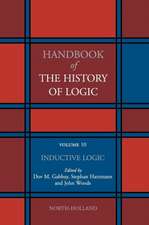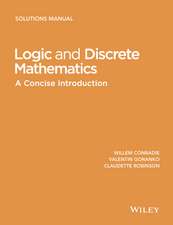Many-Dimensional Modal Logics: Theory and Applications: Studies in Logic and the Foundations of Mathematics, cartea 148
Autor A. Kurucz, F. Wolter, M. Zakharyaschev, Dov M. Gabbayen Limba Engleză Hardback – 20 oct 2003
We start with concrete examples of applied one- and many-dimensional modal logics such as temporal, epistemic, dynamic, description, spatial logics, and various combinations of these. Then we develop a mathematical theory for handling a spectrum of 'abstract' combinations of modal logics - fusions and products of modal logics, fragments of first-order modal and temporal logics - focusing on three major problems: decidability, axiomatizability, and computational complexity. Besides the standard methods of modal logic, the technical toolkit includes the method of quasimodels, mosaics, tilings, reductions to monadic second-order logic, algebraic logic techniques. Finally, we apply the developed machinery and obtained results to three case studies from the field of knowledge representation and reasoning: temporal epistemic logics for reasoning about multi-agent systems, modalized description logics for dynamic ontologies, and spatio-temporal logics.
The genre of the book can be defined as a research monograph. It brings the reader to the front line of current research in the field by showing both recent achievements and directions of future investigations (in particular, multiple open problems). On the other hand, well-known results from modal and first-order logic are formulated without proofs and supplied with references to accessible sources.
The intended audience of this book is logicians as well as those researchers who use logic in computer science and artificial intelligence. More specific application areas are, e.g., knowledge representation and reasoning, in particular, terminological, temporal and spatial reasoning, or reasoning about agents. And we also believe that researchers from certain other disciplines, say, temporal and spatial databases or geographical information systems, will benefit from this book as well.
Key Features:
• Integrated approach to modern modal and temporal logics and their applications in artificial intelligence and computer science
• Written by internationally leading researchers in the field of pure and applied logic
• Combines mathematical theory of modal logic and applications in artificial intelligence and computer science
• Numerous open problems for further research
• Well illustrated with pictures and tables
Din seria Studies in Logic and the Foundations of Mathematics
- 15%
 Preț: 328.09 lei
Preț: 328.09 lei - 23%
 Preț: 521.67 lei
Preț: 521.67 lei -
 Preț: 396.72 lei
Preț: 396.72 lei - 78%
 Preț: 296.05 lei
Preț: 296.05 lei -
 Preț: 343.74 lei
Preț: 343.74 lei - 23%
 Preț: 563.29 lei
Preț: 563.29 lei - 20%
 Preț: 794.22 lei
Preț: 794.22 lei - 27%
 Preț: 945.54 lei
Preț: 945.54 lei - 27%
 Preț: 1016.48 lei
Preț: 1016.48 lei - 46%
 Preț: 747.62 lei
Preț: 747.62 lei - 20%
 Preț: 1211.66 lei
Preț: 1211.66 lei - 31%
 Preț: 590.36 lei
Preț: 590.36 lei - 27%
 Preț: 868.94 lei
Preț: 868.94 lei - 27%
 Preț: 741.59 lei
Preț: 741.59 lei - 20%
 Preț: 639.95 lei
Preț: 639.95 lei - 27%
 Preț: 849.60 lei
Preț: 849.60 lei - 23%
 Preț: 734.18 lei
Preț: 734.18 lei - 27%
 Preț: 1390.23 lei
Preț: 1390.23 lei - 27%
 Preț: 787.87 lei
Preț: 787.87 lei - 39%
 Preț: 771.37 lei
Preț: 771.37 lei - 23%
 Preț: 1014.52 lei
Preț: 1014.52 lei - 27%
 Preț: 783.34 lei
Preț: 783.34 lei
Preț: 1126.74 lei
Preț vechi: 1408.43 lei
-20% Nou
Puncte Express: 1690
Preț estimativ în valută:
215.60€ • 225.68$ • 179.45£
215.60€ • 225.68$ • 179.45£
Carte tipărită la comandă
Livrare economică 31 martie-14 aprilie
Preluare comenzi: 021 569.72.76
Specificații
ISBN-13: 9780444508263
ISBN-10: 0444508260
Pagini: 766
Dimensiuni: 156 x 234 x 34 mm
Greutate: 1.3 kg
Editura: ELSEVIER SCIENCE
Seria Studies in Logic and the Foundations of Mathematics
ISBN-10: 0444508260
Pagini: 766
Dimensiuni: 156 x 234 x 34 mm
Greutate: 1.3 kg
Editura: ELSEVIER SCIENCE
Seria Studies in Logic and the Foundations of Mathematics
Cuprins
I Introduction
1 Modal logic basics 1.1 Modal axiomatic systems 1.2 Possible world semantics 1.3 Classical first-order logic and the standard translation 1.4 Multimodal logics 1.5 Algebraic semantics 1.6 Decision, complexity and axiomatizability problems
2 Applied modal logic 2.1 Temporal logic 2.2 Interval temporal logic 2.3 Epistemic logic 2.4 Dynamic logic 2.5 Description logic 2.6 Spatial logic 2.7 Intuitionistic logic 2.8 'Model level' reductions between logics
3 Many-dimensional modal logics 3.1 Fusions 3.2 Spatio-temporal logics 3.3 Products 3.4 Temporal epistemic logics 3.5 Classical first-order logic as a propositional multimodal logic 3.6 First-order modal logics 3.7 First-order temporal logics 3.8 Description logics with modal operators 3.9 HS as a two-dimensional logic 3.10 Modal transition logics 3.11 Intuitionistic modal logics
II Fusions and products
4 Fusions of modal logics 4.1 Preserving Kripke completeness and the finite model property 4.2 Algebraic preliminaries 4.3 Preserving decidability of global consequence 4.4 Preserving decidability 4.5 Preserving interpolation 4.6 On the computational complexity of fusions
5 Products of modal logics: introduction 5.1 Axiomatizing products 5.2 Proving decidability with quasimodels 5.3 The finite model property 5.4 Proving undecidability 5.5 Proving complexity with tilings
6 Decidable products 6.1 Warming up: Kn x Km 6.2 CPDL x K_m 6.3 Products of epistemic logics with Km 6.4 Products of temporal logics with Km 6.5 Products with S5 6.6 Products with multimodal S5
7 Undecidable products 7.1 Products of linear orders with infinite ascending chains 7.2 Products of linear orders with infinite descending chains 7.3 Products of Dedekind complete linear orders 7.4 Products of finite linear orders 7.5 More undecidable products
8 Higher-dimensional products 8.1 S5 x S5 x ... x S5 8.2 Products between K4 x K4 x ... x K4 and S5 x S5 x ... x S5 8.3 Products with the fmp 8.4 Between K x K x ... x K and S5 x S5 x ... x S5 8.5 Finitely axiomatizable and decidable products
9 Variations on products 9.1 Relativized products 9.2 Valuation restrictions
10 Intuitionistic modal logics 10.1 Intuitionistic modal logics with Box 10.2 Intuitionistic modal logics with Box and Diamond 10.3 The finite model property
III First-order modal logics
11 Fragments of first-order temporal logics 11.1 Undecidable fragments 11.2 Monodic formulas, decidable fragments 11.3 Embedding into monadic second-order theories 11.4 Complexity of decidable fragments of QLogSU(N) 11.5 Satisfiability in models over (N,<) with finite domains 11.6 Satisfiability in models over (R,<) with finite domains 11.7 Axiomatizing monodic fragments 11.8 Monodicity and equality
12 Fragments of first-order dynamic and epistemic logics 12.1 Decision problems 12.2 Axiomatizing monodic fragments
IV Applications to knowledge representation
13 Temporal epistemic logics 13.1 Synchronous systems 13.2 Agents who know the time and neither forget nor learn
14 Modal description logics 14.1 Concept satisfiability 14.2 General formula satisfiability 14.3 Restricted formula satisfiability 14.4 Satisfiability in models with finite domains
15 Tableaux for modal description logics 15.1 Tableaux for ALC 15.2 Tableaux for K(ALC) with constant domains 15.3 Adding expressive power to K(ALC)
16 Spatio-temporal logics 16.1 Modal formalisms for spatio-temporal reasoning 16.2 Embedding spatio-temporal logics in first-order temporal logic 16.3 Complexity of spatio-temporal logics 16.4 Models based on Euclidean spaces
Epilogue. Bibliography. List of tables. List of languages and logics. Symbol index. Subject index.
2 Applied modal logic 2.1 Temporal logic 2.2 Interval temporal logic 2.3 Epistemic logic 2.4 Dynamic logic 2.5 Description logic 2.6 Spatial logic 2.7 Intuitionistic logic 2.8 'Model level' reductions between logics
3 Many-dimensional modal logics 3.1 Fusions 3.2 Spatio-temporal logics 3.3 Products 3.4 Temporal epistemic logics 3.5 Classical first-order logic as a propositional multimodal logic 3.6 First-order modal logics 3.7 First-order temporal logics 3.8 Description logics with modal operators 3.9 HS as a two-dimensional logic 3.10 Modal transition logics 3.11 Intuitionistic modal logics
II Fusions and products
4 Fusions of modal logics 4.1 Preserving Kripke completeness and the finite model property 4.2 Algebraic preliminaries 4.3 Preserving decidability of global consequence 4.4 Preserving decidability 4.5 Preserving interpolation 4.6 On the computational complexity of fusions
5 Products of modal logics: introduction 5.1 Axiomatizing products 5.2 Proving decidability with quasimodels 5.3 The finite model property 5.4 Proving undecidability 5.5 Proving complexity with tilings
6 Decidable products 6.1 Warming up: Kn x Km 6.2 CPDL x K_m 6.3 Products of epistemic logics with Km 6.4 Products of temporal logics with Km 6.5 Products with S5 6.6 Products with multimodal S5
7 Undecidable products 7.1 Products of linear orders with infinite ascending chains 7.2 Products of linear orders with infinite descending chains 7.3 Products of Dedekind complete linear orders 7.4 Products of finite linear orders 7.5 More undecidable products
8 Higher-dimensional products 8.1 S5 x S5 x ... x S5 8.2 Products between K4 x K4 x ... x K4 and S5 x S5 x ... x S5 8.3 Products with the fmp 8.4 Between K x K x ... x K and S5 x S5 x ... x S5 8.5 Finitely axiomatizable and decidable products
9 Variations on products 9.1 Relativized products 9.2 Valuation restrictions
10 Intuitionistic modal logics 10.1 Intuitionistic modal logics with Box 10.2 Intuitionistic modal logics with Box and Diamond 10.3 The finite model property
III First-order modal logics
11 Fragments of first-order temporal logics 11.1 Undecidable fragments 11.2 Monodic formulas, decidable fragments 11.3 Embedding into monadic second-order theories 11.4 Complexity of decidable fragments of QLogSU(N) 11.5 Satisfiability in models over (N,<) with finite domains 11.6 Satisfiability in models over (R,<) with finite domains 11.7 Axiomatizing monodic fragments 11.8 Monodicity and equality
12 Fragments of first-order dynamic and epistemic logics 12.1 Decision problems 12.2 Axiomatizing monodic fragments
IV Applications to knowledge representation
13 Temporal epistemic logics 13.1 Synchronous systems 13.2 Agents who know the time and neither forget nor learn
14 Modal description logics 14.1 Concept satisfiability 14.2 General formula satisfiability 14.3 Restricted formula satisfiability 14.4 Satisfiability in models with finite domains
15 Tableaux for modal description logics 15.1 Tableaux for ALC 15.2 Tableaux for K(ALC) with constant domains 15.3 Adding expressive power to K(ALC)
16 Spatio-temporal logics 16.1 Modal formalisms for spatio-temporal reasoning 16.2 Embedding spatio-temporal logics in first-order temporal logic 16.3 Complexity of spatio-temporal logics 16.4 Models based on Euclidean spaces
Epilogue. Bibliography. List of tables. List of languages and logics. Symbol index. Subject index.
Recenzii
"This book will be a valuable reference for the modal logic researcher. It can serve as a brief but useful introduction (....) for the suitably qualified newcomer. And it contributes a careful and rewarding comprehensive account of some of the latest foundational results in the area of combining modal logics." --Mark Reynolds, The University of Western Australia. Studia Logica, 2004.
















